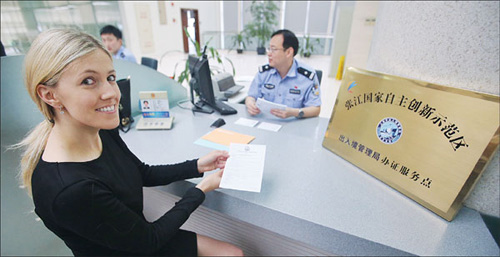Global experts' services made more convenient
Shanghai Zhangjiang National Innovation Demonstration Zone has consistently explored effective ways to attract top professionals and talents from around the world to play a critical role in boosting scientific innovation.
For example, Zhangjiang has established 18 overseas talent bases in 34 countries and regions around the world, through which it selects high-end personnel for integration into the zone's technological resources, projects and capital.
As a result, more than 100 projects have been introduced to Zhangjiang via these overseas talent bases. One of them, focusing on a method for cutting semiconductor wafers, led by Wang Zhongke, was a candidate for the R&D 100 Awards in the United States. The team has finished developing prototypes in Singapore, and has now registered a company in the zone's Songjiang Hi-Tech park.

A foreign employee receives assistance at an exit and entry service office in Zhangjiang. [Photo provided to China Daily]
The zone has also gathered a large number of talents through major scientific projects, including those focusing on stem cell research, quantum communications, medical big data and advanced sensors. More than 470 experts from both China and overseas participate in these projects.
Another key model for cultivating talents is the establishment of training and practice bases in the zone's key enterprises. A total of 12 personnel training and practice bases have been established by the industry-leading companies throughout the zone, which aims to accelerate the development of talents, technology and management. More than 3,000 people have taken part in the training programs since the beginning of this year.
Besides that, the demonstration zone also encourages close connections between academia and industry. Through the cooperation between universities and enterprises, 18 labs have been launched to develop professionals and integrate studying, research and production.
Under such a collaborative mechanism, university professors become research team leaders, and students working in the labs earn extra academic credits. Universities and companies cooperate to commercialize their research achievements. There are currently 18 such labs with 6,400 postgraduate students in the zone.
 Contact Us
Contact Us

 Brilliant light show to illuminate Huangpu River
Brilliant light show to illuminate Huangpu River Maple leaves paint splendid scenery in Pudong
Maple leaves paint splendid scenery in Pudong Appreciate alluring lotus blossoms in Pudong's Century Park
Appreciate alluring lotus blossoms in Pudong's Century Park New pedestrian street boosts Pudong's night economy
New pedestrian street boosts Pudong's night economy 


